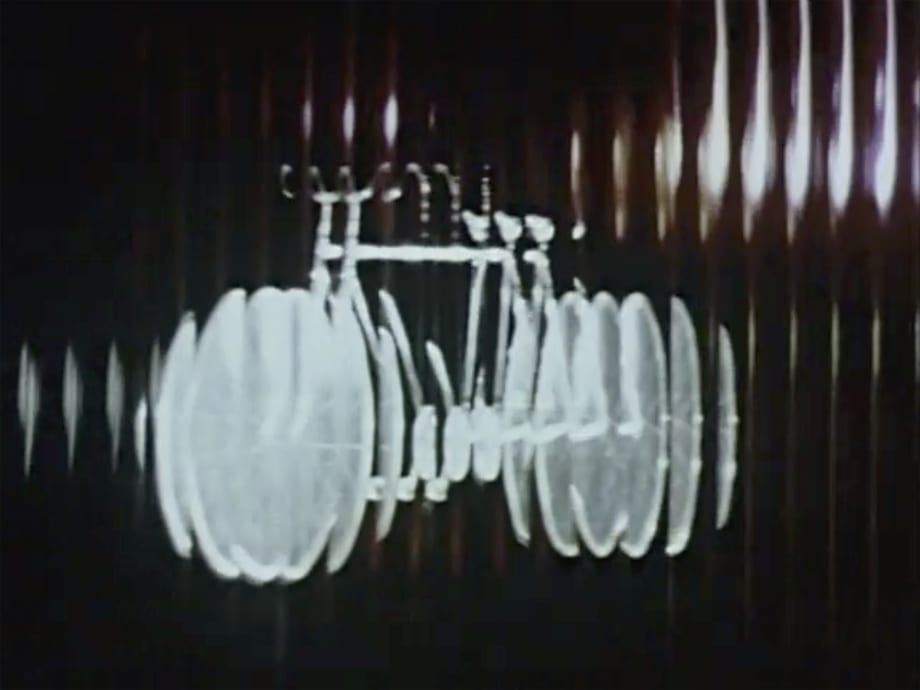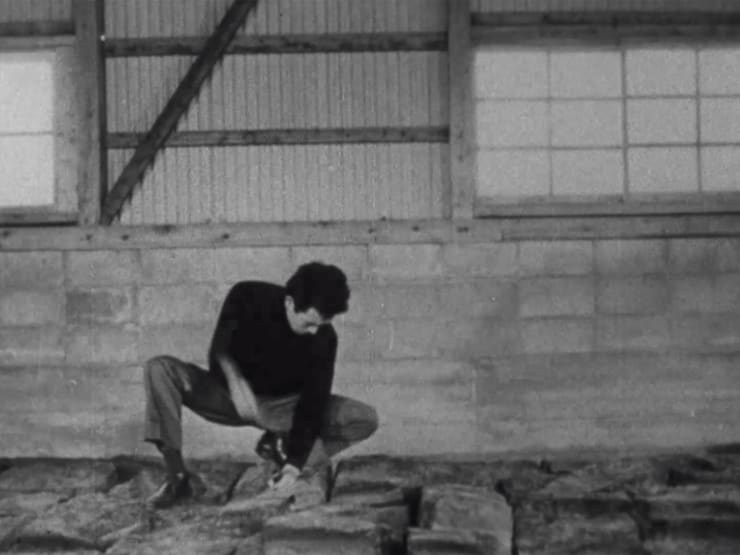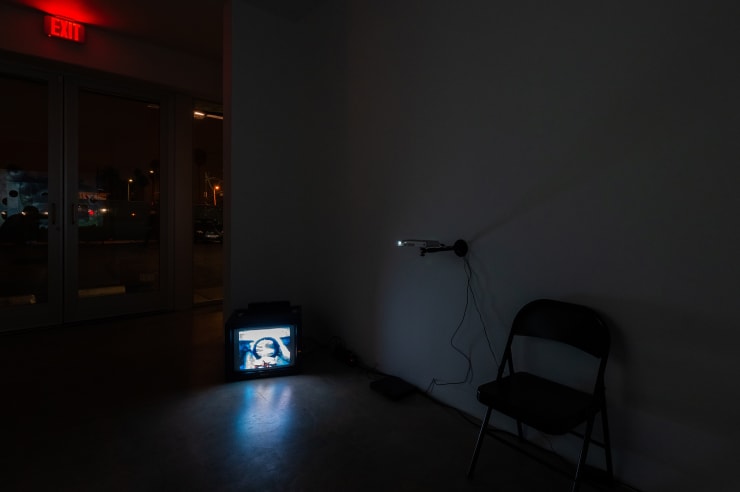Toshio Matsumoto
Nonaka-Hill is pleased to present a solo exhibition of works by Toshio Matsumoto from November 17 – December 22, 2018.
Matsumoto Toshio (born 1932) is a Japanese film director and video artist. After graduating from the University of Tokyo, where he majored in aesthetics, Matsumoto began working at Shinriken Films, a documentary-film production company. His first job as director was to make Ginrin (Silver Ring, 1956), an experimental promotional film. Jikken Kobo members Yamaguchi Katsuro, Kitadai Shozo, and Takemitsu Toru were also involved in the production.
In the late ’50s, Matsumoto began making a new type of documentary that fused avant-garde and documentary elements. Nishijin (The Weavers of Nishijin, 1961) was awarded the San Marco Silver Lion and Haha-tachi (Mother, 1967) the San Marco Golden Lion (Grand Prix) at two different Venice International Documentary Film Festivals.
At the same time, Matsumoto wrote essays on film theory. In 1963, he published Eizo no hakken: Avangyarudo to dokyumentarii (The Discovery of Film: The Avant-Garde and Documentary), which exerted a strong influence on the Japanese film movement.
In the late ’60s, Matsumoto began to devote himself to experimental films and expanded cinema with Tsuburekakatta migime no tame ni (For the Damaged Right Eye, 1968). In 1969, he directed Bara no soretsu (Funeral Parade of Roses), a commercial narrative film that exemplified gay culture and the turmoil of the era. In 1970, he served as general director of the Textile Pavilion at the Japan World Exposition held in Osaka, where he presented Space Project Ako, a huge multiprojection video work. Yokoo Tadanori was in charge of the design for the pavilion.
Matsumoto subsequently expanded his activities, producing countless cross-genre works including commercial narrative films such as Shura (1971) and Dogra magra (1988), experimental films such as Atman (1975) and Engram: Kioku konseki(Engram: Memory Traces, 1987), and video artworks such as Metastasis: Shinchintaisha (Metastasis: Metabolism, 1971) and Shift danso (Shift, 1982). Matsumoto played a vital role as a pioneering figure in Japanese experimental film. His most recent work, Toro (Praying Mantis), was released in 2012.
(Biography provided by Postwar Japan Moving Image Archive.)
 Toshio MatsumotoGinrin(銀輪), 195535mm12min
Toshio MatsumotoGinrin(銀輪), 195535mm12min Toshio MatsumotoFor the Damaged Right Eye(つぶれかかった右眼のために), 196816mm x313min
Toshio MatsumotoFor the Damaged Right Eye(つぶれかかった右眼のために), 196816mm x313min Toshio MatsumotoAtman(アートマン), 197516mm11min
Toshio MatsumotoAtman(アートマン), 197516mm11min Toshio MatsumotoConnection(コネクション), 198116mm10min
Toshio MatsumotoConnection(コネクション), 198116mm10min Toshio MatsumotoDissimulation(ディシミュレーション=偽装), 1992VTR20min
Toshio MatsumotoDissimulation(ディシミュレーション=偽装), 1992VTR20min Toshio MatsumotoEverything Visible Is Empty(色即是空), 197516mm8min
Toshio MatsumotoEverything Visible Is Empty(色即是空), 197516mm8min Toshio MatsumotoMona Lisa(モナリザ), 197316mm3min
Toshio MatsumotoMona Lisa(モナリザ), 197316mm3min Toshio MatsumotoEngram(エングラム=記憶痕跡), 198716mm15min
Toshio MatsumotoEngram(エングラム=記憶痕跡), 198716mm15min Toshio MatsumotoA Girl(青女), 197516mm30min
Toshio MatsumotoA Girl(青女), 197516mm30min Toshio MatsumotoPhantom(ファントム=幻妄), 197516mm10min
Toshio MatsumotoPhantom(ファントム=幻妄), 197516mm10min Toshio MatsumotoMurder Catalog(殺人カタログ), 1975VTR10min
Toshio MatsumotoMurder Catalog(殺人カタログ), 1975VTR10min Toshio MatsumotoMetastasis(メタスタシス=新陳代謝), 197116mm8min
Toshio MatsumotoMetastasis(メタスタシス=新陳代謝), 197116mm8min Toshio MatsumotoShift(シフト=断層), 198216mm10min
Toshio MatsumotoShift(シフト=断層), 198216mm10min Toshio MatsumotoExpansion(エクスパンション=拡張), 197216mm14min
Toshio MatsumotoExpansion(エクスパンション=拡張), 197216mm14min Toshio MatsumotoThe Song of Stone(石の詩), 196316mm24min
Toshio MatsumotoThe Song of Stone(石の詩), 196316mm24min Toshio MatsumotoSway(スウェイ=ゆらぎ), 198516mm8min
Toshio MatsumotoSway(スウェイ=ゆらぎ), 198516mm8min Toshio MatsumotoWhite Hole(ホワイトホール), 197916mm7min
Toshio MatsumotoWhite Hole(ホワイトホール), 197916mm7min Toshio MatsumotoWave(ウェーブ), 198416mm8min
Toshio MatsumotoWave(ウェーブ), 198416mm8min
Related artist
Artist Exhibited:
Ulala Imai
Kazuo Kadonaga
Kentaro Kawabata
Zenzaburo Kojima
Kisho Kurokawa
Tadaaki Kuwayama
Toshio Matsumoto
Keita Matsunaga
Yutaka Matsuzawa
Kimiyo Mishima
Kunié Sugiura
Takuro Tamayama
Tiger Tateishi
Sofu Teshigahara
Shomei Tomatsu
Wataru Tominaga
Hosai Matsubayashi XVI
Kansuke Yamamoto
Masaomi Yasunaga
Exhibitions:
-2025-
Sea of Mud, Wall of Flame: Satoru Hoshino and Masaomi Ysunaga
KEY HIRAGA: The Elegant Life of Mr. H
-2024-
KYOKO IDETSU: What can an ideology do for me?
KENTARO KAWABATA / BRUCE NAUMAN
SAORI (MADOKORO) AKUTAGAWA: CENTENARIA
Keita Matsunaga : Accumulation Flow
-2023-
NONAKA-HILL ♥ TATAMI ANTIQUES: A holiday sale of unique objects from Japan
TAKASHI HOMMA : REVOLUTION No.9 / Camera Obscura Studies
TATSUMI HIJIKATA THE LAST BUTOH: Photographs by Yasuo Kuroda
Kiyomizu Rokubey VIII: CERAMIC SIGHT
Masaomi Yasunaga: 石拾いからの発見 / discoveries from picking up stones
SHUZO AZUCHI GULLIVER ‘Synogenesis’
Koichi Enomoto: Against the day
Tatsuo Ikeda / Michael E. Smith
Hiroshi Sugito: the garden with Zenzaburo Kojima
Zenzaburo Kojima: This very green
Tomohisa Obana: To see the rainbow at night, I must make it myself
Daisuke Fukunaga: Beautiful Work
- 2021 -
Natsuyasumi: In the Beginning Was Love
Takashi Homma: mushrooms from the forest
– 2020 –
Hosai Matsubayashi XVI & Trevor Shimizu
Sterling Ruby and Masaomi Yasunaga
– 2019 –
A show about an architectural monograph
Yutaka Matsuzawa
Yutaka Matsuzawa through the lens of Mitsutoshi Hanaga
Takuro Tamayama & Tiger Tateishi
Kunié Sugiura
Masaomi Yasunaga
Miho Dohi
Wataru Tominaga
Naotaka Hiro
Parergon: Japanese Art of the 1980s and 1990s
Tadaaki Kuwayama
– 2018 –
Toshio Matsumoto
Kentaro Kawabata
Kansuke Yamamoto
Kazuo Kadonaga: Wood / Paper / Bamboo / Glass
Press:
-2025-
OCULA, Kaoru Ueda
Galerie, Kaoru Ueda
Ceramic Now, Satoru Hoshino and Masaomi Yasunaga
ARTFORUM, Sawako Goda
Artillery Magazine, Sawako Goda
-2024-
Artsy, Nonaka-Hill
Richesse, Nonaka-Hill Kyoto
Bijutsutecho, Nonaka-Hill Kyoto
The Art Newspaper, Nonaka-Hill Kyoto
Meer, Kyoko Idetsu
Bijyutsutecho, Masaomi Yasunaga
Switch, Masaomi Yasunaga
ARTnews JAPAN, Masaomi Yasunaga
Richesse, Masaomi Yasunaga
Art Basel, Daisuke Fukunaga, Imai Ulala
Art Basel, Kazuo Kadonaga, Sofu Teshigahara
-2023-
ADF webmagazine, Yasuo Kuroda, Tatsumi Hijikata
e-flux, Sanya Kantarofsky, Yasuo Kuroda
Los Angeles Times, Kenzi Shiokava
Artillery, Masaomi Yasunaga
Contemporary Art Daily Shuzo Azuchi Gulliver
- 2022 -
Contemporary Art Daily, Tomohisa Obana
ARTE FUSE, Daisuke Fukunaga
Contemporary Art Daily, Daisuke Fukunaga
Contemporary Art Review Los Angeles (Carla), Daisuke Fukunaga
What's on Los Angeles, Daisuke Fukunaga
Hyperallergic, Daisuke Fukunaga
Artillery, Kentaro Kawabata
Larchmont Buzz, entaro Kawabata
- 2021 -
Art Viewer, Natsuyasumi: In the Beginning Was Love
Hyperallergic, Natsuyasumi: In the Beginning Was Love
Art Viewer, Takashi Homma
Hyperallergic, Busy Work at Home
Art Viewer, Busy Work at Home
Hyperallergic, Ulala Imai
Contemporary Art Review Los Angeles (Carla), Ulala Imai
Contemporary Art Daily, Ulala Imai
artillery, Ulala Imai
Special Ops, Ulala Imai
Art Viewer, Ulala Imai
artillery, Matsubayashi & Trevor Shimizu
– 2020 –
Ceramic Now, Sterling Ryby and Masaomi Yasunaga
Hypebeast, Sterling Ryby and Masaomi Yasunaga
Art Viewer, Sterling Ruby and Masaomi Yasunaga
Air Mail, Sterling Ruby and Masaomi Yasunaga
Los Angeles Times, Kaz Oshiro
ArtnowLA, Kaz Oshiro
What's on Los Angeles, Kaz Oshiro
KCRW, Kaz Oshiro
Tique, Kaz Oshiro
Contemporary Art Daily, Kaz Oshiro
Art Viewer, Kaz Oshiro
Contemporary Art Daily, Sofu Teshigahara
Art Viewer, Sofu Teshigahara
KCRW, Sofu Tsshigahara
Hyperallergic, Nonaka-Hill
Los Angeles Times, Keita Matsunaga
– 2019 –
Los Angeles Times, Tatsumi Hijikata
Art Viewer, Tatsumi Hijikata, Eikoh Hosoe
Contemporary Art Review Los Angeles, Tatsumi Hijikata, Eikoh Hosoe
ArtAsiaPacific, Yutaka Matsuzawa
Los Angeles Times, Tatsumi Hijikata
AUTRE, Tatsumi Hijikata, Eikoh Hosoe
Los Angeles Times, Nonaka-Hill
ARTFORUM, Takuro Tamayama, Tiger Tateishi
Art Viewer, Takuro Tamayama, Tiger Tateishi
KCRW, Nonaka-Hill
LA WEEKLY, Nonaka-Hill
AUTRE, Takuro Tamayama, Tiger Tateishi
ArtsuZe, Takuro Tamayama, Tiger Tateishi
ARTFORUM, Review: Tadaaki Kuwayama, Rakuko Naito
Art Viewer, Masaomi Yasunaga, Kunié Sugiura
Los Angeles Times, Masaomi Yasunaga
KQED, Tadaaki Kuwayama, Rakuko Naito
Contemporary Art Daily, Naotaka Hiro, Wataru Tominaga, Miho Dohi
Los Angeles Times, Miho Dohi
Los Angeles Review of Books, Miho Dohi
Bijutsu Techo, Naotaka Hiro, Wataru Tominaga, Miho Dohi
Art Viewer, Miho Dohi
Art & Object, Parergon
COOL HUNTING, Felix Art Fair
Art Viewer, Tadaaki Kuwayama
artnet news, Nonaka-Hill
Contemporary Art Review Los Angeles (Carla), Tadaaki Kuwayama
– 2018 –
Art Viewer, Kentaro Kawabata
Contemporary Art Daily, Kazuo kadonaga
Los Angeles Times, Kazuo Kadonaga
ARTFORUM, Kazuo Kadonaga
Contemporary Art Daily, Shomei Tomatsu
KCRW, Kimiyo Mishima, Shomei Tomatsu
This website uses cookies
This site uses cookies to help make it more useful to you. Find out more about cookies.







































